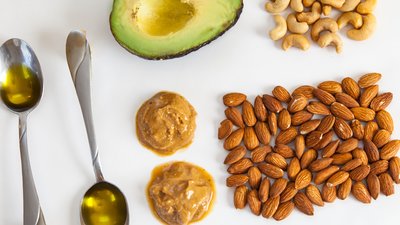Fats and cholesterol are the building blocks of key hormones such as thyroid hormone, estrogen, testosterone, and cortisol. Under normal circumstances, when fat accounts for less than 15 percent of total calories, the production of those hormones begins to suffer. This has negative consequences for everything from fat burning and muscle growth to fertility and mood. Inadequate fat intake also impairs absorption of essential fat-soluble vitamins (A, D, E, and K), each of which has an important biological role.
On the flip side, getting more than 40 percent of total calories from fats can come at the expense of protein and fiber. Excessive intake of fats—which are the most calorie-dense nutrient at 9 calories per gram—can lead to unwanted weight gain, especially in people not accustomed to higher-fat diets.
The official recommendation from the American Dietetic Association is to get 20-35 percent of total calories from fat.[1] Based on my review of the literature, 0.3-0.5 grams of fat per pound of your goal body weight is adequate for optimizing hormone levels and meeting other physiological needs such as the absorption of fat-soluble vitamins, structure and funtion of cell membranes, blood clotting, wound healing, and brain and neuron function.
Dietary fat also helps suppress appetite by activating specific hormones in the gut and by slowing digestion.[2] Fats can also slow the release of nutrients from the small intestine, helping to promote stable blood sugar and a healthy glucose metabolism.
Choosing the Right Fats for Fat Loss
Certain types of fats are more beneficial for fat loss than others. A diet high in monounsaturated and polyunsaturated fatty acids, such as avocado, nuts, and fatty fish, has been shown to reduce insulin resistance. Insulin resistance is a dominant risk factor for type 2 diabetes and is often associated with obesity and high blood pressure.[3]

Omega-3 fatty acids are a type of polyunsaturated fat found in fatty fish, flaxseed, chia seeds, and walnuts. Omega-3s have been shown to enhance the health benefits associated with regular exercise, as well as reduce hunger cravings. Both can help you achieve your fat-loss goals![4,5]
Avoid trans fats, though. Found in processed foods containing partially hydrogenated oils, these fats are a significant risk factor for cardiovascular disease. Go easy on the saturated fat, too. Too much of it, along with inadequate intake of monounsaturated and omega-3 fats, can hinder fat loss. And it just might increase your risk of insulin resistance, obesity, and metabolic syndrome.[3] All can lead to type 2 diabetes.

While trans fats should be avoided completely, we do need a minimum amount of saturated fats for hormone regulation, cell messaging, and immune function. Certain saturated fats, like coconut oil, are rich in MCTs (medium-chain triglycerides) which can increase fat oxidation and may be beneficial for weight management. Other sources of saturated fats, like egg yolks and butter, are rich in essential fat-soluble vitamins, like A, D, E, and K.
Nevertheless, the current consensus among health authorities like the Harvard School of Health and the American Dietetic Association, based on reviews of all the available research, is that saturated fat should be limited to 10 percent or less of total calories.[1,6]
Still Fuzzy About Fats?
- Monounsaturated fats: olives and olive oil, canola oil, avocados and avocado oil, almonds, macadamias and most other nuts, sesame seeds, and pumpkin seeds
- Polyunsaturated fats (including omega-3): salmon, sardines, mackerel, herring, ground flaxseed and flaxseed oil, chia seeds, walnuts and walnut oil, and canola oil
- Saturated fats (limit to 10% total calories): coconuts and coconut oil, palm oil, butter and ghee, egg yolks, grass-fed red meats, free-range poultry, and full-fat dairy

The Bottom Line
Consuming all the "fat-loss foods" in the world will not reduce body fat unless you're eating fewer calories than you burn. You've probably heard it before, and the science still holds true: Calorie deficit is the chief requirement for fat loss.
Start by figuring out your total caloric requirements (factoring in exercise), reducing calories by 15-30 percent for fat loss, subtracting your protein and fat requirements, then using nutrient-dense carbohydrates to fill your remaining energy needs.
References
- Kris-Etherton, P. M., Innis, S., & Ammerican, D. A. (2007). Position of the American Dietetic Association and Dietitians of Canada: dietary fatty acids. Journal of the American Dietetic Association, 107(9), 1599-1611.
- Little, T. J., Horowitz, M., & Feinle-Bisset, C. (2007). Modulation by high-fat diets of gastrointestinal function and hormones associated with the regulation of energy intake: implications for the pathophysiology of obesity. The American Journal of Clinical Nutrition, 86(3), 531-541.
- Riccardi, G., Giacco, R., & Rivellese, A. A. (2004). Dietary fat, insulin sensitivity and the metabolic syndrome. Clinical Nutrition, 23(4), 447-456.
- Parra, D., Ramel, A., Bandarra, N., Kiely, M., Martínez, J. A., & Thorsdottir, I. (2008). A diet rich in long chain omega-3 fatty acids modulates satiety in overweight and obese volunteers during weight loss. Appetite, 51(3), 676-680.
- Hill, A. M., Buckley, J. D., Murphy, K. J., & Howe, P. R. (2007). Combining fish-oil supplements with regular aerobic exercise improves body composition and cardiovascular disease risk factors. The American Journal of Clinical Nutrition, 85(5), 1267-1274.
- "The Truth about Fats: The Good, the Bad, and the In-between - Harvard Health." Harvard Health. N.p., 7 Aug. 2015. Web. 02 Aug. 2016.

